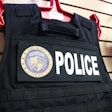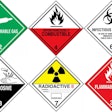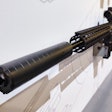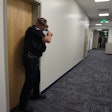People bring some strange things into police station lobbies. Pizzas that were ordered but never picked up. A wide variety of snakes. Hand grenades.
Recently, a man walked into the Camarillo (Calif.) Police Department with one of the latter. The working grenade was one of several explosives said to be inert when he dropped them off in the station lobby. Members of the Ventura County Bomb Squad determined otherwise and suffice to say the station was evacuated until the devices were safely rendered.
Largo (Fla.) Police Department had a visitation from a woman who thought she was just dropping off some shotgun shells. But in going through the shells, an officer found something else in the mix: a half-stick of dynamite. Transported to a radio field, the dynamite was subsequently detonated.
While collecting recyclables roadside, one Chippewa Falls (Wis.) family found an object comprised of a PVC pipe with wires leading from a cap and loaded with nails. This clan had a firecracker of an idea as to what to do with the suspicious device: They picked it up and drove it to the Lake Hallie Police Department, which turned out to be a homemade explosive was detonated by an area bomb squad.
Now, lest it sound like I’m picking on the good citizens we serve, I should say that cops can be just as clueless.
At the City of Industry (Calif.) Sheriff’s Station, we had one deputy actually transport a grenade in the trunk of his patrol car before parking in the station parking lot. Once the grenade was discovered, it was left in the trunk of the deputy’s patrol car and the parking area was immediately taped off pending the response of the Arson/Explosives Detail. Our watch commander was livid and for good reason: The deputy had parked right next to her new Corvette.
“If they blow up my car, “ she warned the deputy. “You’re gonna wish that thing had detonated on your drive over here.”
Fortunately, each of these situations turned out fine.
Unfortunately, this isn’t always the case.
Through no fault of their own, patrol officers don’t know when or where they might come across an explosive device.
Florida State Trooper James Fulford, Jr., had the misfortune of stopping two men who were subsequently taken into custody by Jefferson County deputies. While apparently conducting a search of their vehicle, Fulford came across a package covered with gift wrap. What Fulford didn’t know was that the package contained a microwave with a bomb inside, a device that was to be delivered to a woman by one of the men on behalf of the woman’s ex-husband. The device detonated, killing Fulford instantly.
Even bomb technicians can fall victim to the objects of their expertise.
Widely recognized as one of the world’s best explosive technicians, LAPD Det. Arleigh McCree at one time was offered $140,000 by Libyan dictator Col. Muammar al-Gaddafi to train terrorists how to make bombs. Thankfully, McCree declined. Yet despite his expertise, McCree and his partner, Officer Ronald Ball, were killed while trying to defuse two pipe bombs in a garage.
Despite their lethality, bombs are not at the forefront of most patrol officers’ minds. Objectively, one can’t blame them, either. Historically, such devices don’t pop up as often as, say, men with guns.
But explosives have played a role in some of law enforcement’s greatest tragedies. Here's a quick list dating to the horse and buggy days.
In California, five peace officers were killed when a powder magazine containing a barricaded murder suspect exploded. The suspect had earlier fled into the powder keg, which contained 5-tons of powder, precipitating an overnight standoff. In the morning, the suspect called out to say that he was ready to give up. Deputies approached the magazine in anticipation of arresting the man when the keg suddenly exploded, killing the deputies, a female bystander, the suspect, and seriously injuring two other deputies.
In Chicago, an unknown person threw a bomb at police as they were dispersing a crowd in Haymarket Square. Between the bomb blast and ensuing gunfire, eight police officers and an unknown number of civilians were killed.
In 1917, a box was found in the Milwaukee Police Station. A station keeper was showing the box to the shift commander when the device inside detonated, killing eight officers. It is believed the bomb was planted by anarchists who had left it in a field where it’d been found before being carried to the station.
Because of an explosive’s potential to inflict great loss of life and the availability of Internet accessible information on how to build them, we may start seeing more incidences of their use.
Bombs have figured prominently in the works of the SLA, the Weathermen, the Columbine shooters, the Unabomber, and abortion clinic killer Eric Rudolph.
Until recently, our brethren across the waters in the United Kingdom had acquired a degree of undesirable familiarity with such devices courtesy of the IRA. Back at home where a compromised economy and fears of federal usurpation of certain rights (e.g., the Second Amendment) may fuel the anger of certain violent groups, it is not unreasonable to consider increased prospects for acts of domestic terrorism.
But next to a citizen dropping a bomb in your lap, your greatest threat may be your own desire not to appear overly vigilant or cowardly in handling suspicious packages. For one, cops generally have that “take charge” mindset we so demand of them. For another, many don’t want to “impose” upon others.
Perhaps you should impose on others.
When Lt. Clifford T. Hill of the Bessemer (Ala.) Police Department decided to help his mayor’s secretary open a package, it exploded, killing him. An investigation determined that the package contained a bomb intended for the new public safety commissioner from a disgruntled cop who would have been appointed police chief had the new public safety commissioner—his intended target—not been elected.
Most suspicious devices and packages are left where they are discovered. This allows explosives units to investigate the devices and try to determine their threat level. Sometimes, the decision is made to detonate the object as a precaution.
Many objects thought to possibly be explosives turn out to be something else. Abandoned parcels that have been blown up include laptops, cartons of cigarettes, and a box of chocolates with a love letter.
A recurrent source of investigative concern are radiosondes that descend from burst meteorological balloons launched by the National Weather Service (NWS). These devices are carried back to earth on little parachutes and contain instructions to mail them to the NWS. But occasionally, people mistake these atmospheric measurement devices for explosives. Such cases of mistaken identity have found them subject to investigative scrutiny when found atop cargo containers (South Carolina State Port Authority’s terminal), in mail collection boxes (Tavernier, Fla.) and laying in the road (Upton, Mass.).
When it comes to determining if something might be an explosive (and I hope to hear from others with greater expertise on the matter than me), there are some red flags to watch out for, particularly as they pertain to mailed packages.
Location. Likely targets include airports, bus and train depots, government offices, courthouses. family planning clinics, religious centers, and tolerance museums. Most of the time, abandoned packages turn out to be a transient’s abandoned suitcase or some businessman’s forgotten satchel.
But not always.
While many explosive packages are left at a particular location, many—as the death of Lt. Clifford Hill illustrates—are sent through the mail.
Tell-tale signs for suspected mail parcels include excessive postage, marks emphasizing “PERSONAL,” lack of return address, excessive tape (which, unfortunately, describes about 90 percent of your Ebay purchases, as well), out of country origins, and notations promising “a prize inside” or “your lucky day has arrived!”
Explosive situations happen once in a blue moon. But it only takes one to ruin your whole day. When dealing with anything that might be an explosive, treat it as if it is, and don’t hesitate to get someone who knows how the hell to deal with it.
Don’t rush to judgment. The most important fuse is your own: Make sure it’s long when it comes to patience.













